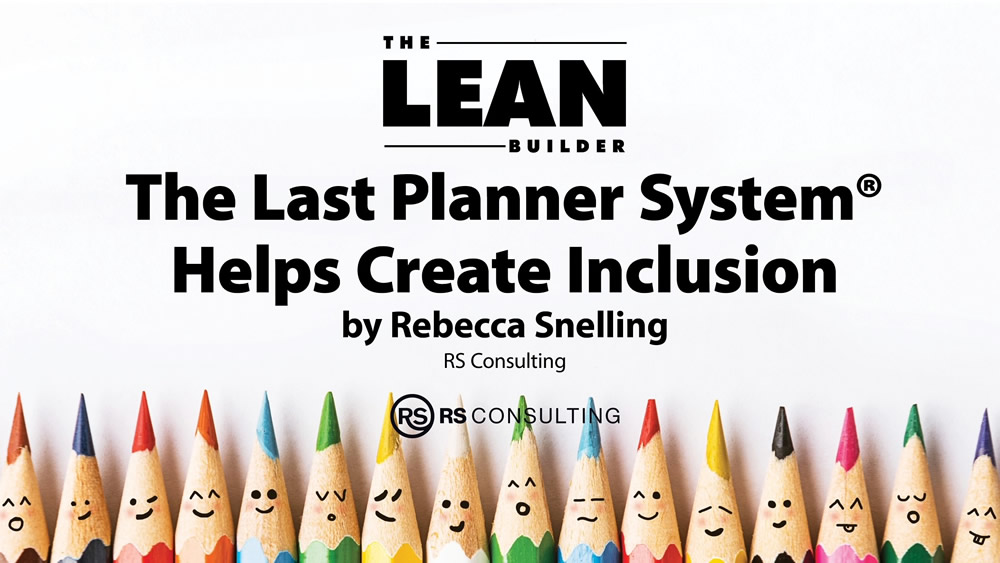The AEC industry has had an intentional focus on Diversity and Inclusion over the past five or so years, as we should. Some of the many benefits of inclusion are:
- Safer jobsites,
- More engagement,
- Lower turnover,
- Higher innovation,
- Higher productivity,
- Increased personal accountability, and
- Better results!
Create Inclusion
Did you know that utilizing the Last Planner System® (LPS) effectively actually helps drive more inclusion on a jobsite? Here are some of the underlying subtleties that drive not only the best LPS results, but great inclusion results as well.
One of the main points in the LPS is to plan in more detail as you get closer to the work, involving the “right people” at the right time to be able to make reliable promises to each other. The “right people” are the last ones to plan the work (hence the name “Last Planner” System) with the authority to commit to manpower, especially as you are getting into Phase Pull Plans, Making Work Ready, Weekly Work Plans, and Daily Huddles. When well executed, all the Last Planners contribute their thoughts, ideas, and commitments to the plan.
Create Inclusion and Engagement
Creating a Phase Pull Plan effectively requires input as we talk through the logic, sequence, and flow of the plan. Ideally, we see thoughts and input from all the trades represented. When we are missing a trade or have one who is reluctant to contribute to the plan, we get a less-cohesive result that also includes less buy-in.
When we review the Six Week Lookahead with an effort to “Make Work Ready,” we see input from planners as they identify and share their constraints. When teams can’t drive this participation and inclusion, we often find constraints getting identified too late, sometimes even after the trade is trying to do the work. On the flip side, teams who do a great job of including everyone’s voices tend to be able to execute work that is constraint-free because constraints have been identified and removed in advance of the commitment in the weekly work plan.
Psychological Safety
Building on the steps above, to make a reliable promise for work to be done next week, the Last Planners need to be allowed and empowered to say, “No, I can’t do that,” if that is the case. At the same time, we also want to see our teams plan aggressively. The key is to talk about it so we don’t end up with gains in one trade that can’t be captured by the next trade.
An example might be, “I will definitely have the drywall on the third floor complete by the end of the day Wednesday, but I think there’s a good chance I can get it done on Tuesday.” This is typically only done when we see high degrees of psychological safety. This is the belief that one will not be punished or humiliated for speaking up with ideas, questions, concerns, or mistakes and that the team is safe for interpersonal risk-taking. (Learn more about this concept by Amy Edmondson on Psychological Safety.)
One of the tricky things about psychological safety is that no single person can simply feel it, declare it, and expect everyone else to feel it. It takes someone to create the environment for psychological safety, and it also takes confidence of team members to feel psychologically safe enough to speak up and contribute.
Learning Together
The crucial components of the daily huddle are for team members to share what got done as planned, what did not get done as planned, what new challenges are being seen, and what replanning needs to happen. This creates a great opportunity to learn together, which feeds the cycle of growing psychological safety! To achieve the best results in learning from the breakdown, the voices and thoughts of many people are included in the discussion.
The Last Planner System was designed to work via inclusion of the people who are doing the work. It’s incumbent upon us to focus on inclusion on our projects. If we’re intentional about it, we can utilize the LPS to help drive higher and better inclusion, as the results of the two are intertwined.
These are a few of the connection points that I’ve seen between “inclusion” and the LPS. What other connection points do you see?
Related Blogs
The Last Planner System® and the Trades: It’s Up to You to Teach Them
The Power of Daily Huddles: Building Stronger Teams and Projects









